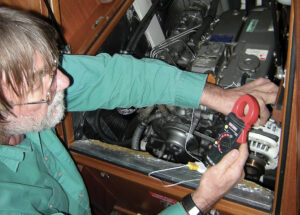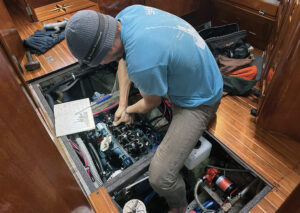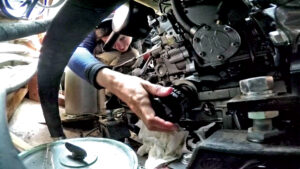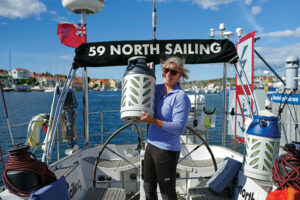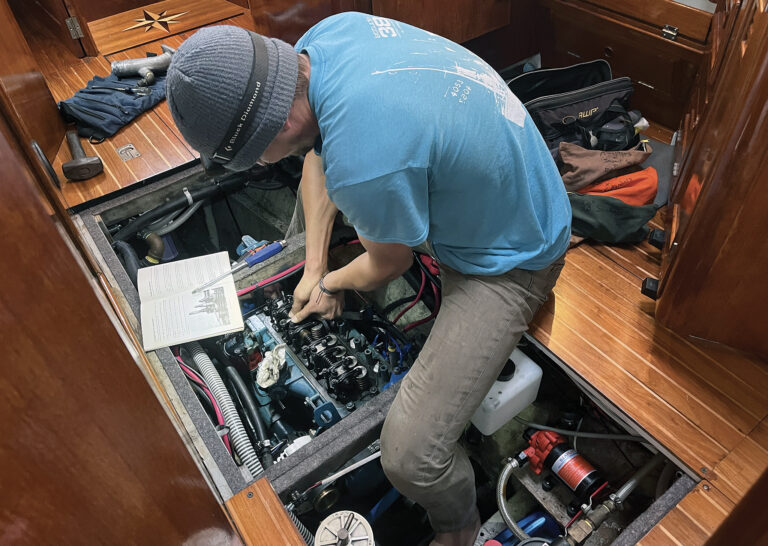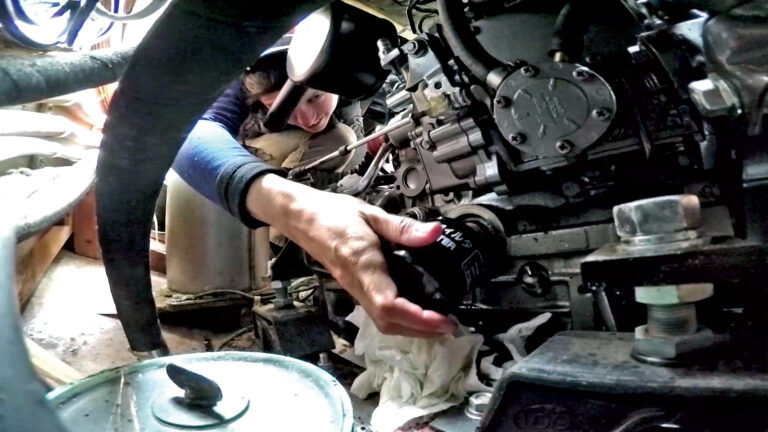It felt like a wicked haunting, a cruel sense of déjà vu, as Chris once again found himself head down in the engine compartment, covered in oil and diesel. The swearing, though fitting, echoed the frustration of the ongoing engine saga on our Cheoy Lee 41, Avocet. Despite thinking we had left our engine troubles behind in California after a runaway incident, we were back at square one—perhaps even worse off. Our Perkins 4.108 had failed us again, this time reducing itself to nothing more than a very expensive, non-functioning piece of ballast.
Surely our certified, rebuilt high-pressure fuel pump couldn’t be the cause of another near disaster, right? As soon as we limped into Banderas Bay from Isla Isabel and set our hook, Chris dug right into the project to confirm that, once again, the fuel pump was to blame.

“This is going to be worth writing about,” Chris grumbled as he studied the disassembled engine, surrounded by tools, rags, and that ever-present smell of diesel permeating our lives.
After verifying that we had good compression in the cylinders and that the rest of the engine was in good shape, we decided to rebuild it rather than replace it. Replacing the engine would’ve been costly, complicated by the approaching hurricane season and Mexico’s challenging import system. It wasn’t an easy decision, but it was necessary for the time being. With a rough plan in place, we ordered a brand-new high-pressure fuel pump from a U.S. company, in addition to all new gaskets for everything.
To save on marina fees, we opted to tackle a majority of the rebuild at anchor, despite the added difficulties. With the thermal winds kicking up every afternoon our boat rocked like a bronco, but we were undeterred—well, most of the time.

The first day was all about logistics: how to get a 600-pound engine out of our cramped cabin space. Chris hopped in the dinghy, and when he returned he had a 12-foot, 6-x-6 timber precariously balanced across our 8-foot Fatty Knees tender. With the timber run across the top of the salon and through the portlights, and a chain hoist loaned to us by Richard from S/V Sourdough—a fellow Perkins owner—we were ready to lift the engine.
But it wasn’t that simple. The drive plate had seized and wouldn’t budge. After some “creative destruction” (aka cutting it out), Chris finally freed the engine from the transmission. With some added teamwork from the crew of S/V Sitka and careful maneuvering, we hoisted the engine free from its tight compartment.
What remained was an oily, daunting 6-foot-deep pit where the engine had once sat. It was a mess, but boats have a way of letting you know what needs attention. Now, it was time to turn Avocet’s dark, grimy corners into something to be proud of—making lemonade out of lemons, I suppose…oily, diesel-soaked lemons.

Drab to Fab
Since we thought our five-year refit was behind us, we didn’t pack any Tyvek suits when we set off cruising in 2022—a lesson quickly learned when we realized they were impossible to find in Banderas Bay. Chris, ever determined, ground our fiberglass bilge and engine compartment without one, after creating a plastic tent to corral the insidious fiberglass dust.
Despite lacking the proper protective gear, Chris powered through, protected only by a respirator and Carhartt pants. After years of boatbuilding, fiberglass didn’t bother him like it did others—though what seems like a blessing is actually a sign of overexposure to fiberglass. Heed our warning and pack a Tyvek suit, just in case. You never know when you’ll need it, and grinding fiberglass without proper protection is something you don’t want to experience.
In the true spirit of “boatwork in exotic places,” we found ourselves in search of an alternative to our usual go-to paint, Tile-Clad, which was unavailable throughout Banderas Bay. After scouring the area, we settled on PPG semi-gloss white, a two-part epoxy paint from Comex, a store that seemed to pop up on every street corner. With the fiberglass dust meticulously cleaned, thanks to Chris’ careful prep work, we finally began painting.

This was more than just an aesthetic upgrade—it marked the culmination of hours of labor, sweat, and determination. It felt like a fresh start for the heart of our vessel, and, in many ways, for us as well. Each stroke of the brush felt like we were restoring not just the boat but also our confidence in handling whatever challenges cruising threw our way. The engine compartment and bilge, once dingy and oil soaked, now sparkled, transformed into a clean, bright white, giving the boat a fresh, new look and offering a sense of relief. It was a milestone moment, as after a full day of painting, we could proudly say we had officially touched every single inch of Avocet, inside and out.
As the project shifted back to the engine rebuild, we had to remove half of our table to make space. Thankfully, Avocet’s layout allowed the engine to sit in a cluttered but manageable spot, giving Chris access to critical components like the bell housing, flywheel, and timing gears. A Plastigauge test revealed the state of the bearings and crankshaft, confirming what we suspected: The rebuild would be challenging but possible.
Despite identifying the root issue—again—our location in Banderas Bay meant delays with customs. The only solution was to fly Chris to California to retrieve the high-pressure fuel pump and new seals. It was a quick two-day trip, giving Chris the opportunity to collect not only our ordered parts but some additional bits and bobs that we couldn’t find in Mexico.
Returning with the parts was a miracle of its own, as the pump had to be vacuum-sealed to avoid TSA issues (if they detected solvents, they would confiscate it). Once back, we painted all of our freshly sandblasted engine pieces—though we had to settle for Ford Blue instead of the classic Perkins Blue. After reassembling the engine and carefully lowering it back into its rightful place, we couldn’t help but wonder, after all this effort: would it start?


Third Time’s the Charm?
The reason we could take this on ourselves is because Chris isn’t new when it comes to working on engines, having spent his childhood working alongside his late father in the garage, and building a 1963 MGB from the frame up in his pre-teen years. But despite doing everything by the book, our newly rebuilt Perkins 4.108 just wasn’t firing. As if that wasn’t frustrating enough, we didn’t expect the culprit to be the brand-new high-pressure fuel pump that Chris had just flown to California to retrieve but alas…it was.
There it was, our smoking gun. Again. When we investigated, we learned that the company we purchased the pump from evidently had not bench tested it, and in fact it was the wrong pump for our engine. So, we were back at square one with two useless pumps. After some commiserating and discussion, we decided to take the gamble and get our first (original) pump rebuilt, again, in Mexico.
Our friend Richard from Sourdough turned us on to a mechanic in Puerto Vallarta, and after a taxi ride into the depths of the city we met with Manuel, the mechanic, who assured us that he could rebuild our old pump, and it would be “no problema.” We even called our friend Karen to translate and make sure we weren’t missing anything. Manuel looked at us with a mix of tenderness and pity in his eyes as he laughed and assured us once more that it was “no problema” before we left his shop and the remnants of our pump behind.
When we originally had the first pump rebuilt by a certified technician in California, it took a month and two tries to get it back actually finished. Here in Banderas Bay, Manuel had the pump back to us in two days, hand delivered by his friend. In the cockpit, Chris and I carefully unwrapped the fuel pump that was inside a plastic bag covered in glitter–pixie dust, I told Chris, because sometimes all you need is a little faith, trust, and pixie dust. With the glitter dusted off, Chris dashed inside to install the engine’s missing piece, then we went through the motions of firing her up again.
“Ready!” Chris yelled from down below, watching carefully over his work as I sat in the cockpit with the ignition key turned over, my thumb cramping on the start button as I held it down. Thankfully, unlike our prior 24 times, the engine fired up within seconds and we heard her low and steady rumble once again. After a few happy yells, we listened a bit more intently. She wasn’t perfect yet, with a slight knocking sound due to the timing being off, but after a day of adjustments we were ready to go, which meant our time in Banderas Bay was coming to a poetic end.
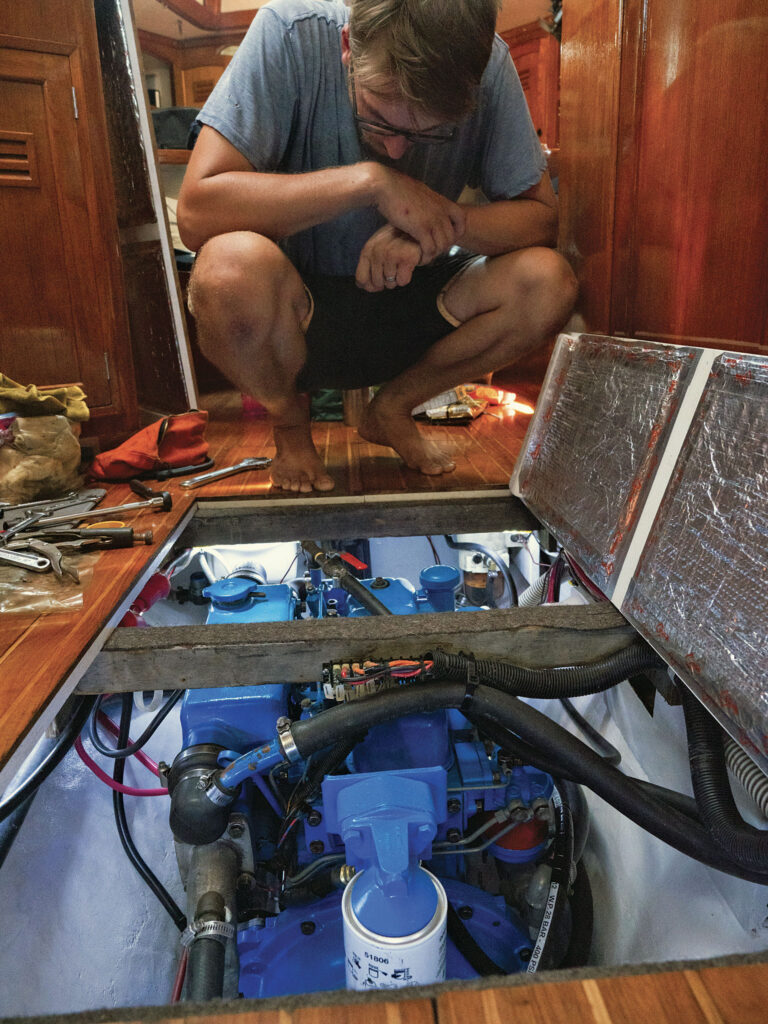
Into the Sea
It was 6:15 a.m. on April 7, 2023, and Chris had just finished checking the oil for the ninth time. The sky was overcast but the sun was bright, welcoming us into the new day. There were only seven boats left in the anchorage, a huge difference from the 70 we had anchored with when we first arrived back in February. I wondered how many we would cross paths with in the Sea of Cortez, assuming we actually would make it there this time. Our course was set for Isla San Francisco, a small island beneath Isla San Jose 383 nautical miles northwest of Banderas Bay. With steady winds and a functioning engine keeping us at a speed of 5 knots we could anticipate making landfall approximately three days later.
Somewhere around 100 miles into our journey the wind absolutely died, so we prayed to Poseidon and turned the engine on. We had a new appreciation for her low rumble that has now become music to our ears. The sound of perseverance, determination, and tenacity. That evening we were treated to the most spectacular sunset with dolphins escorting us. I sat on the bow and watched them scratch their backs against the boat before darting off in various directions. It was a Kodak moment for sure, and a memory we will cherish forever. Chris was right—although this experience was frustrating, it was definitely worth writing about.
May 2025
